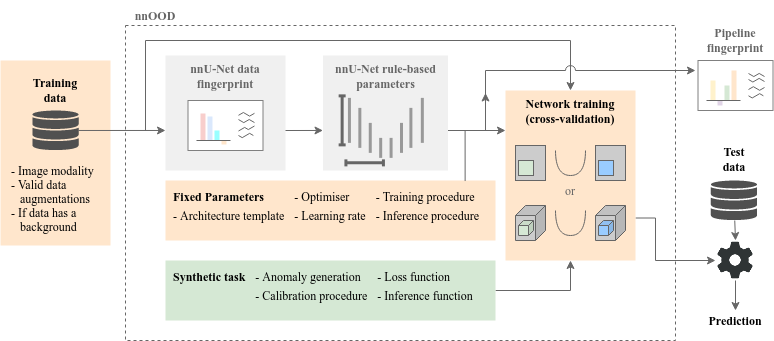Recently there have been a number of anomaly detection methods that introduce synthetic anomalies into otherwise healthy data. The aim of these methods is to generalise to real, unseen anomalies. nnOOD is able to compare these methods under a standardised training regime, based on nnU-Net, where each model is trained to an equal level of saturation (each can perform the selected synthetic task similarly well).
To facilitate future task development, we also provide a compartmentalised framework for constructing tasks based on blending patches (the current state-of-the-art), to facilitate further investigation into this area.
Got any feedback on this project or ideas on how to make it more useful? I'd love to hear them! Open an issue and we can talk it through :).
Overview of the nnOOD framework. The green components are entirely new to nnOOD, orange components differ significantly from their nnU-Net counterparts and grey components have only minor changes.
- Install PyTorch, making sure that you use a version which works with your hardware.
- Install nnOOD using
git clone https://github.com/matt-baugh/nnOOD cd nnOOD pip install -e .
Once installed follow the experiment walkthrough to run nnOOD.
Full details on how to use these entrypoints to run an experiment are available in documentation/experiment_walkthrough.md.
- nnood/experiment_planning/nnOOD_plan_and_preprocess.py
- Given a dataset in the correct format, plan the experiment + model configuration, and optionally prepare the data.
- Dataset should be within folder named in environment variable
nnood_raw_data_base(see nnood/paths.py)
- nnood/training/nnOOD_run_training.py
- Train a model on a given dataset using a given self-supervised task.
- Must have already run nnOOD_plan_and_preprocess for dataset.
- Self-supervised task must be the name of class within
nnood/self_supervised_task, which extends and implements the interface of nnood/self_supervised_task/self_sup_task.py
- nnood/evaluation/nnOOD_run_testing.py
- Predict and evaluate a model, trained on a specified self-supervised task, on the datasets test set.
- Test set is defined as images in
$nnood_raw_data_base/DATASET_NAME/imagesTs - Labels are in
$nnood_raw_data_base/DATASET_NAME/labelsTs. If there is no label present for a sample, we assume it to be normal, so assign a label of all zeroes.
- Foreign Patch Interpolation
- CutPaste
- Poisson Image Interpolation
- Natural Synthetic Anomalies (both source and mixed gradient variants).
Full details on how to implement your own self-supervised tasks, either from scratch or using the modular components for making a patch-blending based task, are available in documentation/synthetic_task_guide.md.
To test or demo components of nnOOD, use the notebooks within notebooks, described in notebooks/readme.md.
